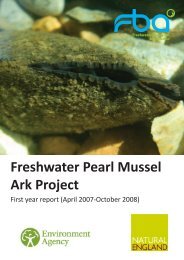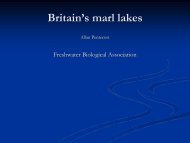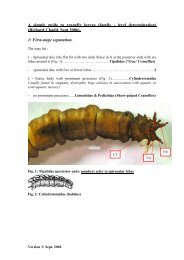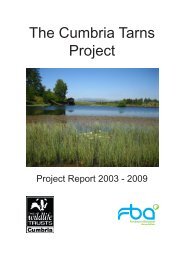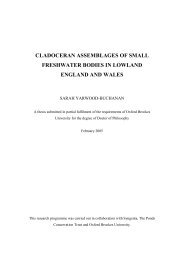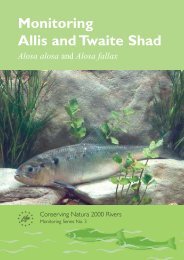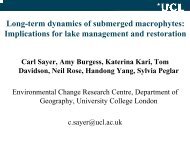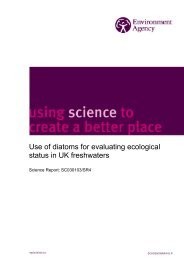Monitoring the Bullhead - European Commission
Monitoring the Bullhead - European Commission
Monitoring the Bullhead - European Commission
You also want an ePaper? Increase the reach of your titles
YUMPU automatically turns print PDFs into web optimized ePapers that Google loves.
depletion were often dominated by larger bullheads (>1+) while <strong>the</strong> later runs were dominated by 0+<br />
bullheads.This is probably because of <strong>the</strong> difficulty in observing and catching 0+ bullheads in early runs<br />
when density of bullheads are high, with older, larger individuals being easier to observe.This latter<br />
finding results in increasing errors of depletion estimates.To overcome this problem, <strong>the</strong> number of<br />
sites that must be surveyed can be large, depending on <strong>the</strong> required precision.The use of depletion<br />
estimates was also found to be labour-intensive and time-consuming. Hence, carrying out five-catch<br />
depletion estimates on a large number of survey sites is not recommended, given financial and<br />
manpower limitations.<br />
Qualitative and semi-quantitative sampling techniques, such as single-catch electric fishing, are less<br />
labour-intensive, and can be used to provide more information on <strong>the</strong> status of fish stocks in a<br />
catchment in terms of abundance, distribution and population structure, albeit at a lower level of<br />
precision. However, estimates of population size can be made if calibration exercises are carried out in<br />
conjunction with <strong>the</strong> qualitative surveys. Fur<strong>the</strong>rmore, for a catchment overview, high precision is not<br />
essential and such a semi-quantitative sampling method can provide cost-effective information on<br />
whe<strong>the</strong>r populations are above a minimum threshold relating to favourable or unfavourable status.<br />
Calibration can be achieved by relating <strong>the</strong> semi-quantitative catch to sampling efficiency derived from<br />
multiple-catch depletion sampling carried out in similar habitat (see Cowx 1996).This method allows<br />
wider geographical coverage that reflects <strong>the</strong> character of a catchment, as more sampling sites can be<br />
surveyed each day.The main limitation of electric fishing for bullhead is that <strong>the</strong> method is restricted to<br />
wadeable streams, which means little information will be available for <strong>the</strong> larger, deeper main-stem<br />
rivers. It is thus recommended that semi-quantitative electric fishing, linked to gear calibration studies, is<br />
used for condition assessment of <strong>the</strong> bullhead in SAC rivers.<br />
4 Sampling protocol<br />
The following sampling protocol is proposed for <strong>the</strong> assessment of conservation status of <strong>the</strong> bullhead.<br />
The objective of <strong>the</strong> monitoring is to detect change in bullhead populations, determine conservation<br />
status and to allow appropriate management intervention.The sampling protocol can be ‘bolted on’ to<br />
existing monitoring programmes to maximise resource use and keep costs low.<br />
4.1 Site selection<br />
<strong>Monitoring</strong> <strong>the</strong> <strong>Bullhead</strong><br />
As electric fishing will be undertaken to provide an overall condition assessment of <strong>the</strong> SAC river<br />
catchment, sites selected must represent <strong>the</strong> distribution and abundance of discrete bullhead<br />
populations. Previous studies on all SAC rivers should enable fisheries scientists to establish, at least<br />
approximately, where <strong>the</strong> upper and lower limits of bullhead populations are within each SAC river. It is<br />
important that tributaries outside SAC boundaries are also sampled, as <strong>the</strong>se may contribute<br />
significantly to <strong>the</strong> sustainability of bullhead populations in <strong>the</strong> SAC as a whole.<br />
The sites selected must provide habitat coverage that encompasses all <strong>the</strong> life stages of <strong>the</strong> bullhead.<br />
The sites should include spawning habitat (coarse substrate with large stones), juvenile habitat (shallow<br />
stony riffles) and adult habitat (cover with <strong>the</strong> presence of large stones).The habitat preference of <strong>the</strong><br />
bullhead is considered synonymous with habitat used by juvenile salmonids, which require riffle/pool<br />
sequences with <strong>the</strong> presence of boulders and cover.Thus, when selecting suitable sites for monitoring<br />
bullhead populations it is recommended that sites currently used for juvenile salmonid monitoring are<br />
reviewed for suitability. The use of existing monitoring sites has a number of advantages:<br />
Habitat requirements of <strong>the</strong> bullhead and juvenile salmonids are similar.<br />
Existing sites are usually well distributed through a particular SAC river catchment, and<br />
probably provide information on distribution of bullheads.<br />
9




